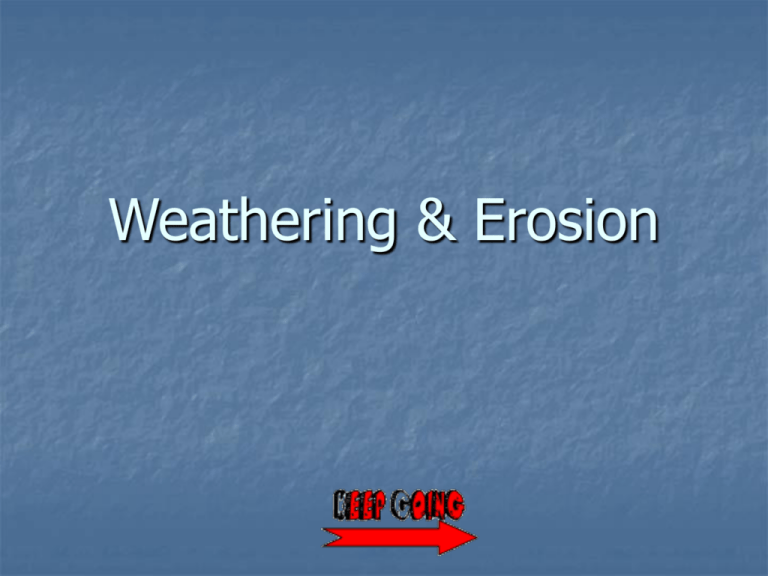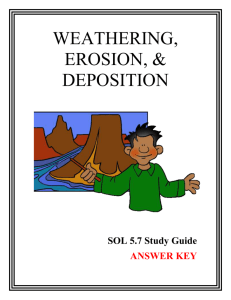Weathering & Erosion
advertisement

Weathering & Erosion All material and information contained in this presentation is used in accordance with the U.S. Copyright law under the fair use agreement. Further use is restricted. What is weathering? Weathering is a set of physical, chemical and biological processes that change the physical and chemical properties of rocks and soil at or near the earth's surface. More about weathering Definition – the breakdown of rock to form sediment [very small pieces of rock] Weathering happens to rocks that are NOT MOVING Weathering is part of the Rock Cycle There are three types of weathering Mechanical [sometimes called physical] Chemical Biological [can be mechanical or chemical] Let’s investigate mechanical weathering first. In mechanical weathering, a rock is broken down into smaller pieces without changing its mineral composition. Mechanical weathering breaks rocks down into smaller pieces. Types of mechanical weathering include frost wedging, exfoliation, and thermal expansion. There are several different processes that cause mechanical weathering. Enchanted rock is a huge example of exfoliation mechanical weathering close to home. Observe the effects of mechanical weathering Click on the arches and follow the instructions to observe mechanical weathering: Observe photographs of the different types of mechanical weathering. Watch the movie to find out more about mechanical weathering: Review mechanical weathering: thermal expansion – heat and cold causing the rocks to expand and contract exfoliation – peeling of layers; In weathering, exfoliation describes sheets of rock peeling off a bare rock face. ice wedging – water freezes and thaws causing rocks to break loose root pry – tree roots causing roots to break apart Now, let’s look at chemical weathering. Chemical weathering breaks rocks down chemically adding or removing chemical elements, and changes them into other materials. Chemical weathering consists of chemical reactions, most of which involve water. In chemical weathering, a rock is broken down by chemical reactions that change its mineral composition and physical and chemical properties Chemical weathering happens when the minerals that make up a rock are changed, leading to the disintegration of the rock Chemical weathering happens quickly in warm, moist environments because water is needed for the chemical reactions. The warm weather speeds up the reactions. Not all minerals are prone to chemical weathering. The rock granite, has very different levels of resistance to chemical weathering than marble. Chemical Weathering also occurs when minerals are dissolved below the surface, resulting in the bedrock being removed. Review chemical and mechanical weathering. Take a quiz: Biological weathering involves processes that can be either chemical or physical in nature. Biological weathering can be considered special types of mechanical or chemical weathering. Biological weathering – What is it? Some biological weathering processes are: 1. Rocks can break because of animal burrowing. 2. Tree roots grow into cracks and widen them, which helps physical weathering. 3. Bacteria, lichens and other organisms secrete acidic solutions, which helps chemical weathering. Lichens on rocks cause biological weathering by secreting acids. Is this physical or chemical weathering? Plants growing in rocks break the rocks apart. Chemical or physical? Large trees break apart rock Burrowing animals break apart rock. Chemical or physical? Now let’s move on to EROSION What is erosion? Erosion is defined as the removal and movement of earth materials by natural agents. Some of these agents include glaciers, wind, water, earthquakes, volcanoes, tornadoes, hurricanes, mud flows, and avalanches. How are erosion & weathering different? Weathering involves two processes [mechanical, chemical] that often work together to break down rocks. Both processes occur in place. No movement is involved in weathering. As soon as a rock particle (loosened by one of the two weathering processes) moves, we call it erosion or mass wasting. Mass wasting is simply movement down slope due to gravity. Rock falls, slumps, and debris flows are all examples of mass wasting. We call it erosion if the rock particle is moved by some flowing agent such as air, water or ice. Click to see examples of rock falls and landslides. Scroll through the pictures. In a nutshell: if a particle is loosened, chemically or mechanically, but stays put, we call it weathering. Once the particle starts moving, we call it erosion. Water is the most important erosional agent and erodes most often as running water in streams or rivers. Water in all its forms is erosional. Raindrops create splash erosion that moves tiny particles of soil. Water collecting on the surface of the soil collects as it moves towards tiny streams and creates sheet erosion. Observe river erosion causing waterfalls Erosion by wind is known as aeolian erosion (named after Aeolus, the Greek god of winds) and usually occurs in deserts. Aeolian erosion of sand in the desert is partially responsible for the formation of sand dunes. Painted Desert National Monument The erosive power of moving ice is actually a greater than the power of water. However since water is much more common, it is responsible for a greater amount of erosion on the earth's surface. Glaciers cause erosion two ways they pluck and abrade. Plucking takes place by water entering cracks under the glacier, freezing, and breaking off pieces of rock that are then moved by the glacier. Abrasion cuts into the rock under the glacier, scooping rock up like a bulldozer and smoothing and polishing the rock surface. Click on arches to see more on glaciers Pic.1 A boulder nearly dislodged due to plucking, Beartooth Plateau, Montana. © William Locke Athabasca Glacier - Jasper, Canada Waves in oceans and other large bodies of water cause coastal erosion. The power of ocean waves is awesome; large storm waves can produce 2000 pounds of pressure per square foot. The pure energy of waves along with the chemical content of the water is what erodes the rock of the coastline. Watch wave erosion Observe landscapes formed by erosion Observe sea cliffs formed by erosion Observe sea caves formed by erosion Wind and Water Erosion Wind and water work together to erode huge rock layers, forming magnificent landforms. Read how these well-know landforms were formed. Let’s look at some erosion close to home. Remember the flood of 2002? Clicking on the picture will take you to a website with several photographs of the erosion that took place at Canyon Lake during the flood. DEPOSITION As erosion occurs, the sediment is moved and then deposited at a new location. The size of the particles determines how far it will travel. Click on the movie to see how sizes of sediment are deposited. Deposition The faster the stream, the larger size sediment can move. As the stream slows down, large sediment is deposited and only small sediment can still move. Deposition in Rivers As water flows in a river, erosion occurs in some areas, deposition occurs in others. Draw a picture of Oxbow Lake and show where erosion and deposition occur. Review weathering & erosion vocabulary with online flashcards. http://www.studystack.com/javastudysta/frames.jsp Note: Some of the terms on the cards have not been covered during this lesson. Read them anyway; it never hurts to expand your vocabulary! The End!






